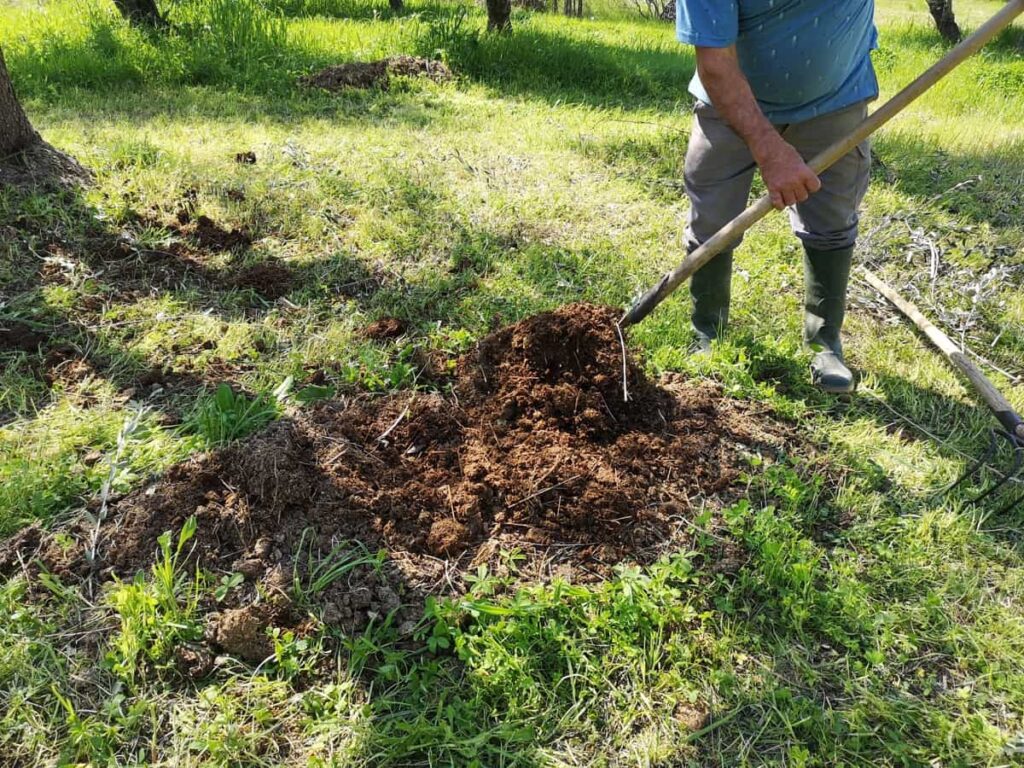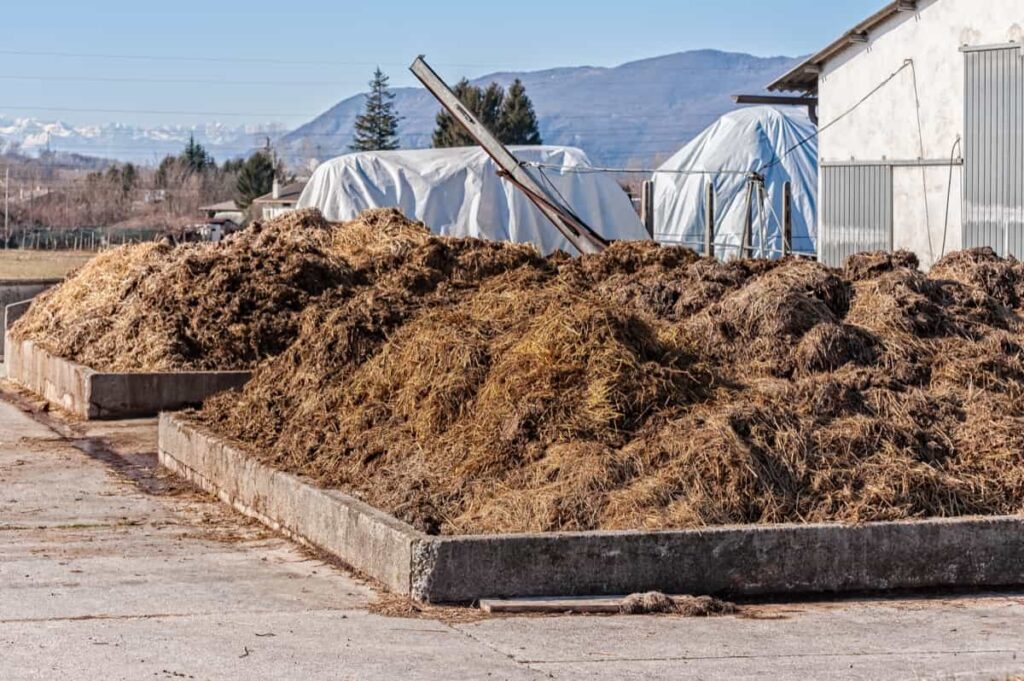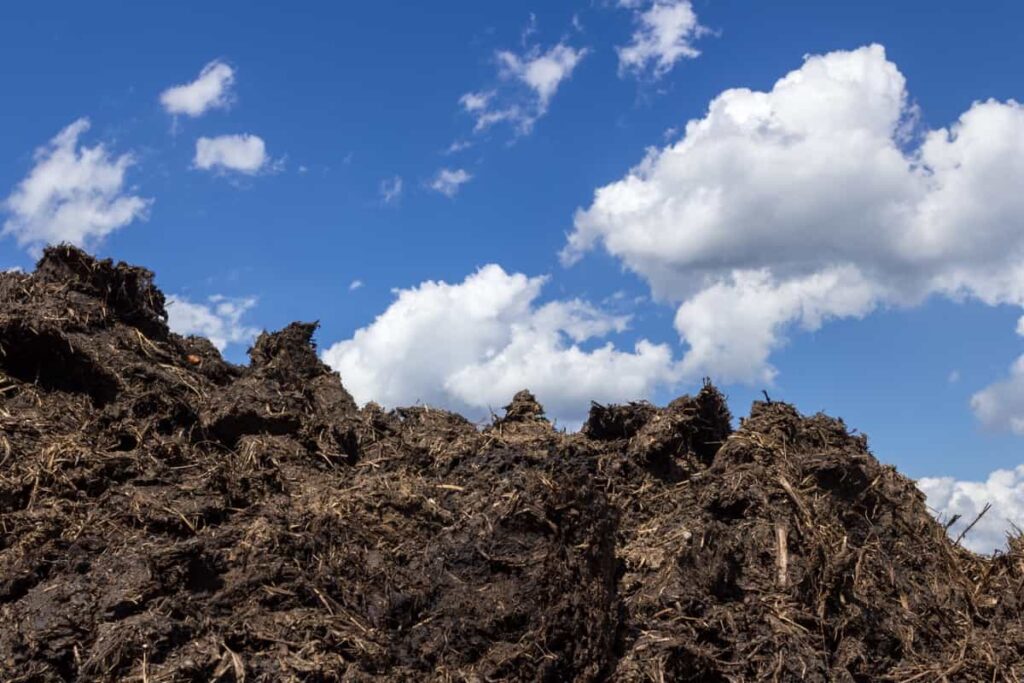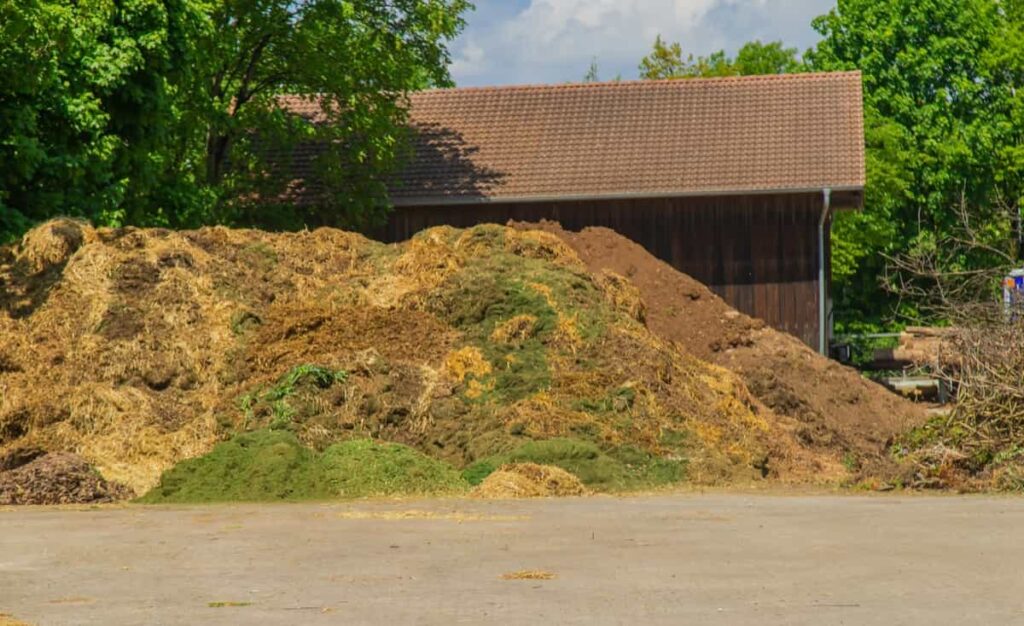Cow manure is a good fertilizer; nevertheless, fresh cow dung has an offensive stench and high amounts of ammonia that can cause plants to be damaged, including an excessive amount of salt. When dung is composted, the stench, salt concentration, and dangerous ammonia levels in fresh dung are eliminated, creating an excellent fertilizer or top dressing. In addition, the manure should be combined with carbon-rich material to speed up the aerobic decomposition process.

It will heat up, destroying many bacteria and weed seeds. Below, we will learn about cow manure as a fertilizer, how to use fresh cow dung compost for your plants, how to use cow dung manure benefits, how to process it into manure, how to compost cow manure quickly, and the cow manure applications. Here’s a step-by-step guide for converting cow dung into manure below.
Sustainable Solutions of Cow Dung Manure
What is Cow Manure?
Cow manure is the waste material or excrement gathered from cattle animals such as cows, buffalo, yaks, and water buffalo. Other names for cow manure include cow dung, cow pat, and cow pies. Mineral content is very high in cow dung, essentially the undigested remnants of plant stuff passed through an animal’s digestive tract. The vast amounts of dung and manure that dairy cows and other cattle animals create are not desired in animal facilities for hygiene reasons.
Other cattle species also produce significant amounts of waste. However, since it includes components and nutrients necessary for developing a plant, it finds widespread use in the agricultural industry. As a result, it is gathered, stored, and ultimately used as fertilizer by various agricultural sectors in the future. The usage of cow dung, which can be obtained from cows, is a method that is both exact and successful in lowering the amount of fertilizer used, which can be detrimental to the soil.
Cow dung is mainly composed of lignin, cellulose, and hemicelluloses. It is composed of feces, urine, and a combination of the two in a ratio of three to one. In addition to these components. In addition, it has 24 distinct minerals, some of which include nitrogen and potassium, along with traces of magnesium, copper, cobalt, sulfur, iron, and manganese. Some of these minerals are in trace amounts.
In case you missed it: Best Organic Fertilizers to Feed Indoor Plants: Homemade and Natural Recipes

What are the Benefits of Cow Manure?
Composting cow dung can result in several useful byproducts. Composting cow dung will rid your soil of hazardous ammonia gas and pathogens, providing copious quantities of organic matter to the soil. Other benefits include the elimination of weed seeds. In addition, you can increase the soil’s ability to store moisture by working some compost into the ground. Because the roots of the plants can utilize more water and nutrients when required, you should water them less.
In addition, it will increase aeration, which will assist in loosening soils that have been compacted. Finally, cow dung that has been composted has a higher concentration of helpful bacteria than uncomposted cow manure. These bacteria convert nutrients into more readily digestible forms to be gently released without damaging sensitive plant roots. As a result, it is composting cow dung results in about one-third fewer emissions of greenhouse gases, further contributing to its positive impact on the environment.
Ingredients and Nutrients in Cow Manure
It is widely known that cow dung contains many mineral components and an extensive quantity of nutritious stuff. Because of its fine texture, higher moisture content, delayed breakdown rate, and low calorific value, cow dung is considered a slow-acting fertilizer. These characteristics set it apart from fast-acting fertilizers. In addition, cow dung contains a total amount of mineral elements and nutritious material that is more than other animal manure.
This is because cow dung produces a higher yield and a bigger overall output than other types of livestock manure. As a result, cow dung has the potential benefits in goods that have value added to them, are safe to use, have a high-efficiency level, and bring about positive economic advantages and social benefits while avoiding and regulating environmental degradation. When composting livestock manure, you will need the manure itself, high-carbon materials such as dried grass clippings, a pitchfork or shovel, and a thermometer. Additionally, you will require manure.
The C: N Ratio
The carbon and nitrogen ratio is the filler mixture’s or the compost’s raw materials’ carbon and nitrogen contents. The carbon and nitrogen ratio is a precise quantity or value between those two components. When organic matter is broken down into compost, microorganisms use carbon as their primary energy source, while nitrogen is their primary supply of nutritional elements.
In case you missed it: How to Make Cow Dung Manure Compost: A Step-by-Step Guide to Use in Your Farm/Garden

The carbon source will transform into carbon dioxide and humus in composting. An organism will ingest the nitrogen content, transform it into nitrate, or vanish in ammonia gas. Composting revolves around this central principle for this same reason. The best carbon-to-nitrogen ratio is 20 to 1. However, it can go up to 30. Therefore, the microbe for aerobic bacteria does not need a temperature either too high or too low.
Process of Converting Cow Dung into Manure
After composting fermentation, deodorization, and sterilization, cattle manure is a valuable resource that may be converted into high-quality and efficient organic manure or compost fertilizer for farmland. Cattle dung can also be used as a fertilizer for fields. It is good knowledge that cattle dung has a dense consistency and a high moisture percentage. On the other hand, it can only vent and compost slowly.
When you are composting, it is important to make sure that you consider a variety of factors, including the investment cost, the composting efficiency, the occupied space, the operation expenditure, the composting size, the composting environment, and so on. Then, combine the manure with other carbon-rich materials to speed up the aerobic composting process. For cow manure, follow the procedure.
Choose a spot where a square pile measuring between three and four feet can be constructed, with sufficient room to rotate it. The specified square area spread out a layer of dry organic material measuring three inches thick. After that, add a layer of manure two inches thick on top of the mound, and then continue adding layers until the pile is four feet tall. Be careful to moisten the pile as you create it so that it is evenly and slightly damp all through.
After that, you can cover it with a thin layer of soil. Next, turn the pile off every three days and keep it wet to prevent it from becoming soggy. While rotating the pile, you should be careful to verify the temperature in its middle. The temperature should be kept between 120 and 160 degrees Fahrenheit. After the compost has acquired a dark brown color and smells earthy, it is ready to be used after the pile’s center has cooled down and stopped heating up.
In case you missed it: Humic Acid Fertilizer Uses: Role, Application Methods, Dosage, and Benefits for Sustainable Agriculture

You Can Produce Compost for a Large Area by Using Machines
By the Windrow Process
Composting in windrows is an effective method for cattle producers to produce organic cow dung compost on their farms. Within twenty days, you will get organic cow dung compost if you place the raw materials in lengthy windrows and use a compost turner designed specifically for windrows. The following are some suggestions to help you compost cow poo more quickly. During the composting process, you must include some water to utilize dried cow dung as a component of your organic fertilizer.
Composting requires the right amount of moisture to operate correctly, speeding up composting cow manure. This process is for when you use fresh cow dung. Before beginning the composting process, you must modify the amount of water in the fresh cow dung if it is used as one of the raw materials. This is because fresh cow dung has an excessively high-water content, which prevents it from being acceptable for the hot composting process (usually up to 85%). So, you should eliminate some moisture as needed.
You have two options for adjusting the amount of water present. The first option is to include a few auxiliary components to soak up any surplus water that can be present in new cow dung. Examples are sawdust, straw, grass ash carbon, and other similar materials. Regarding the alternative option, you may speedily get rid of the water using a dewaters manure machine. The fermented material is recommended to keep at a 60% or less moisture level.
By the Fermentation Grooves Process
The process of composting done in this manner is known as groove composting. This particular form of composting is utilized rather often on cow breeding ranches. Composting the cow manure in the fermentation grooves is simple. However, this is done before the process of natural decay. Composting is different than collecting cow dung and piling it in a tank. You must use a cow dung composting machine with grooves to transform the raw materials.
How to Apply Cow Manure Fertilizer to the Crops?
- Break the soil using tools between two and three inches or even deeper, depending on the plant’s roots.
- Put cow dung manure on the soil at a ratio of 3:1, which means you should mix three parts of the soil with one part of cow dung.
- Ensure the roots are well covered, and add the necessary water to the soil.
In case you missed it: Drip Fertigation in Flower Crops: A Practical Guide for Floriculture Farmers

Different Applications of Cow Manure
Composting cow manure allows more effective utilization of the organic matter, phosphorous, and nitrogen in the manure and some trace elements. It can then be used as organic manure or fertilizer. Cattle dung that has been composted via an industrial compost turner machine offers several benefits, including cheap costs, a large handling capacity, and effective composting, amongst other advantages.
However, aerobic high-temperature fermentation compost can digest large amounts of agricultural straw and other wastes, which means that in addition to being used as fertilizer, it may be utilized to produce edible fungus. Cow manure that has been composted can provide a large number of nutrient elements, assist in the promotion of the improvement of soil structure, assist in the soil’s water permeability and fertilizer retention capacity, and, as a final benefit, assist in the prevention and reduction of environmental pollution and make room for the recycling of resources.
Composting requires several components, including moisture, sufficient nitrogen, and heat. You should always add water to your cow dung compost when you feel like the pile is dry and extra manure if the pile is moist. In addition, if the heap emits a pungent odor that is uncomfortable to the senses, it only indicates that it is either excessively moist or contains excessive manure. Spread it out so that it can dry. If there is an abundance of manure, you can supplement it with more high-carbon material.
In case you missed it: Fertilizer Schedule for Vegetables: Organic, Chemical, How and When to Apply

How Long Does It Take Cow Dung/Manure to Compost?
Manure composting might take 3 to 6 months, depending on how often you mix and stir your pile.
- Broccoli Varieties: Choosing the Right Cultivars for Your Farm
- How to Raise Pigs in Your Own Backyard: A Comprehensive Guide
- Budget Friendly Sheep Shed Ideas: Cheap and Low-Cost Tips
- How Much Do Cattle Farmers Make: Revenue Streams in Cattle Farming
- Management Pests and Diseases in Your Cotton Field
- Sheep Farming Business Plan for Beginners
- Aquaponic Farming at Home: A Step-By-Step Guide
- Profitable Village Farming Business Ideas in 2024
- High-Yield Aquaculture: Fast-Growing Fish for Farming
- Effective Fish Pond Construction Techniques for Beginners
- Irrigation and Water Management in Pineapple Farming
- Blossom to Harvest: Mastering Flowering and Pollination in Papaya Farming
- Pig Fattening Essentials: From Selection to Sale for Beginners
- Raising Wagyu Cattle: A Complete Guide for Premium Beef Production
- Soil Types and Their Water Holding Capacity
- Optimizing Irrigation Schedules for Coconut Groves for Enhanced Yield
- Espresso Your Garden: Coffee Grounds for Healthier Acid-Loving Plants
- The Best Soil Mix for Snake Plants: How to Mix Your Own Snake Plant Soil
- Green Thumb Success: Expert Tips for Cultivating Greenhouse Beans All Year Round
- Bloom All Year Round: The Ultimate Guide to Indoor Hyacinth Care
- Eco-Friendly Gardening: How to Make Liquid Fertilizer from Kitchen Waste
- Ultimate Guide to Grow Anise in Pots: Explore Seed Propagation to Harvesting
- Guide to Raising Chester White Pigs: Discover Breed Facts to Growth Management
- Mastering the Elegance: The Ultimate Guide to Weeping Cherry Tree Care, Planting, and Maintenance
- Ultimate Guide to Planting Garlic in Grow Bags: Growing Strategies for Beginners
- How to Fix Spider Plant Leaf-Related Problems: Natural and Organic Remedies
- 10 Reasons Why Your Tulsi Plant is Shedding Leaves: Home Remedies and Solutions
- Optimizing Growth and Yield: The Advantages of Palm Bunch Ash Fertilizer
- Utilizing Neem Oil Extract as a Natural Pesticide for Hydrangea
- From Soil to Harvest: Various Ways in Which Farmers Can Use AI Tools
- Steps to Encourage and Induce Citrus Flowers: A Comprehensive Guide
- How to Fix Snake Plant Leaf-Related Issues: Natural and Organic Remedies
- Transform Your Garden into a Fragrant Oasis with Raat Ki Rani (Night Blooming Jasmine)
- Discover the Ideal Chicken Breeds for Philippine Farms
- How to Create a Poultry Egg Farm Business Plan for Profits
- Grow Lemon Cucumbers Like a Pro: Insider Techniques for Bountiful Yields

wow, I am so happy after reading this blog, we need more techniques like these.